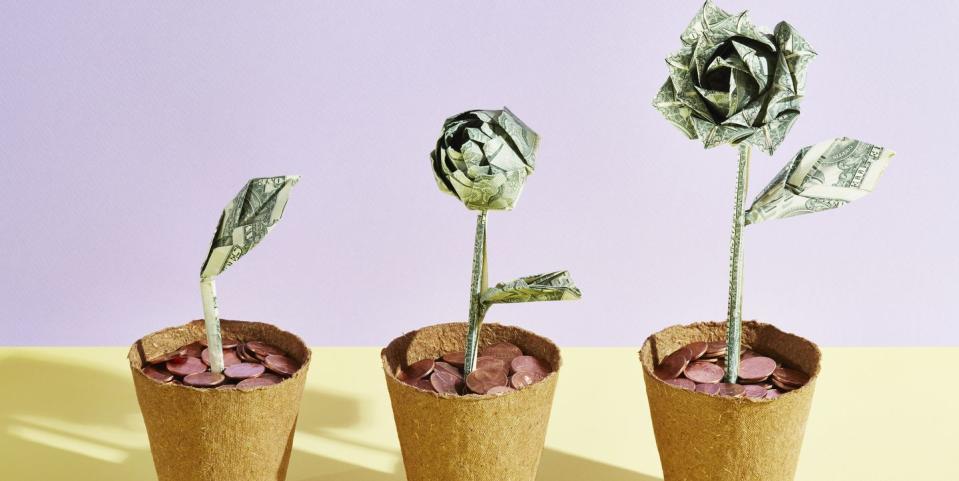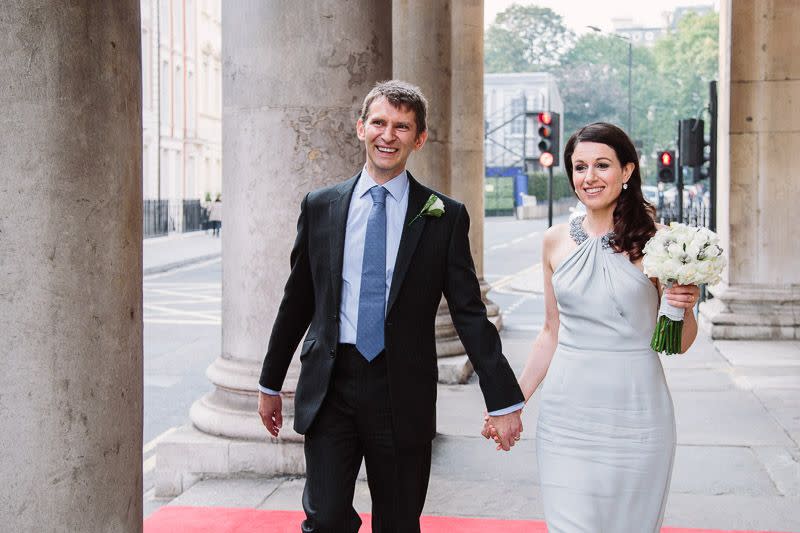How life can be good again after cancer

Annabel Chown is a writer and yoga teacher at Triyoga. Three years on from first telling her story in Red, she reflects here on life and love after cancer....
"Your boobs look fab," says the photographer I’ve hired for a pregnancy shoot. She’s the first person – husband and doctors aside – who has seen them since my double mastectomy two years earlier.
"They’re fake," I tell her. I explain I had breast cancer at 31, when I got away with a lumpectomy. But over a decade later, I discovered I carried a mutated gene, putting me at high risk of a new cancer, so had a risk-reducing mastectomy.
I scroll through her finished photos and see my breasts through an outsider’s eyes for the first time. Upright and symmetrical, they are beautiful. Once, I’d never have believed this possible.
I found the lump in April 2002 in the early hours of a Sunday morning, undressing after a party at a basement bar on Charlotte Street in Soho. A couple of the gold sequins on my neckline were loose. As I touched them, my fingers also met the surprising hardness of the surrounding skin.
"You need chemotherapy and radiotherapy," the oncologist told me in late May, studying the pathology report from my lumpectomy. "Have chemo on a Friday," he continued. "Back to work on Monday. Doesn’t waste too much time." Six months of treatment – time out of my ordinary life that he made sound so unnervingly simple. But I never returned to an office.
Cancer ruptured the structure of my life. It shocked me to my core that I was so young and seemingly healthy and could get such a terrifying disease. Those first months after diagnosis, my mind magnified every ache, every cough. Did these signify a new cancer lurking inside a body I was now petrified of? Chemotherapy made me violently sick, and the accompanying steroid tablets kept me awake most of the night.
When I was diagnosed, I’d only shared my news with close friends and family. I didn’t want pity or people worrying I might die. Paola and Anat, my two best friends, were by my side every step of the way, Paola accompanying me to chemo and holding my hand as I almost screamed with pain when the cold cap – an unsuccessful attempt to save my hair – was placed over my scalp. My friendship with them is now even deeper, and although they were almost strangers before, they’ve since established their own close bond together.
Although I expected to be exhilarated the day my treatment ended in December 2002, instead I missed the routine of the oncology unit, even the white arm of the radiotherapy machine tracing its daily arc across my breast.
I mourned all I’d lost: my trust in my body; my hair; my busy work and social lives. I was in my early 30s, living with my parents and had no idea what my future held.

Career, love, motherhood, the plan of how my life was meant to unfurl had disappeared along with the golden feeling that my body was strong and invincible.
I’d had eight months off work and, during that time, I unearthed latent passions such as writing and yoga. When I did start work again, in early 2003, it was as a freelance architect from home.
Before, my life choices were based on how impressive they sounded, like being an architect at one of London’s most up-and-coming practices, with its high pressure and long hours. But cancer gave me the courage to redesign my life and to make choices based on how much fulfilment they could bring.
This is how, in 2008, I became a yoga teacher. Yoga was my anchor during treatment, reminding me to connect with my breath and the moment I was in rather than endlessly panicking about whether my illness would recur.
I found so much solace in the beautiful architecture of its poses, when I could forget I was a cancer patient, and plug in to a part of myself that felt vibrant and peaceful, despite everything.
Once my treatment was over, yoga helped me to rebuild my strength – in time, creating a body that was stronger than it had been before my diagnosis.
The morning after I was diagnosed, as I was being rushed off for bone and liver scans (which thankfully showed my cancer hadn’t spread), the anaesthetist came into my room. He told me the story of a famous pianist patient who’d had breast cancer.
"She’s now playing better than ever, and to even bigger audiences," he said. "How can life be better after cancer?" I thought. But it can. Before I had cancer, I rushed around all the time, pushing myself through late-night gym workouts.
My new life was more spacious, and I would check in with what I really needed; I was gentler with myself. Cancer instilled a deep-rooted desire to lean towards happiness.
As the years elapsed since my diagnosis and I clocked up a run of clear check-ups, my fear slowly receded. "Does it ever go away completely?" I asked my oncologist. "Probably not," she replied. "But it’s like throwing a pebble into water and watching the ripples spread further and further apart."
Hearing about someone famous dying of breast cancer would trigger my fear, as would going for my annual ultrasound and mammogram. But, gradually, I no longer felt defined by cancer and became absorbed by my work, my yoga practice, my friendships, my writing. I bought a flat and I travelled, attending yoga retreats in Thailand and Goa.
In 2007, five years after my diagnosis, I finally signed up for online dating. It wasn’t a conscious decision to wait so long, but perhaps the five-year all-clear from my oncologist – a watershed, especially for the aggressive triple negative cancer I had, which, if it’s going to return, usually does in those first few years – helped me to feel ready.
While I never hid my breasts from the men I dated, only one ever asked about my scar. I didn’t bother telling the few others I slept with, as they weren’t serious. Perhaps they didn’t notice or felt awkward asking. In some ways, it was a relief. I didn’t always want to go through the whole story.
However, as soon as I met Mark, now my husband, I needed him to see who I really was. I found him on Guardian Soulmates in December 2009. In person, he was a down-to-earth Northerner, and by the end of our second date, I longed for him to kiss me.

He never asked about my scar. Until I pointed it out, he didn’t even notice it. Two months into our relationship, I had a cancer scare. But Mark was steadfast in his support. "Whatever happens, I’m sticking around," he said. "I’m falling in love."
In the middle of our first blissful summer together, I found out two of my cousins had also been diagnosed with breast cancer. I tried to convince myself it was just a horrible coincidence, but I learned that my father’s side of my family carries the BRCA1 gene.
Given my history, there was a 98% chance that I too had inherited this gene, which meant my chance of a new breast cancer developing was as high as 80%. I oscillated between denial and terror, obsessively checking my breasts for a new lump.
And I was angry that having made it eight years past my diagnosis, the threat of cancer once again loomed. I was offered a risk-reducing double mastectomy or annual MRI scans, which are the best way of picking up disease in younger BRCA carriers. Unable to yet face what I viewed as the brutality of a mastectomy, I chose the latter.
It wasn’t until December 2016 that I opted to have a mastectomy. I was tired of the claustrophobia-inducing MRI tunnel, tired of waiting for the results, fearful that this year my luck would run out. And I’d read a memoir by a glamorous New Yorker, a BRCA carrier who’d had the same surgery and was delighted with the results.
I recovered quickly from the surgery. My new breasts, with implants, looked great. They did have limited sensation, and while it was strange to touch a part of my body that was once so receptive and feel so little, with that also came the relief that this was now a much safer territory.
I was proud of my body and how beautifully it had healed. So I was surprised when, around four months after the surgery, I started to feel really low. Even though I now had my wonderful husband, I once again questioned what my future held.
For four years, we had been trying to conceive. Now in my mid-40s, I couldn’t shake the feeling that the door to motherhood was closing. Life, I felt, had let me down.
"I promise you’ll shine very brightly again, as you always do," Anat texted. For weeks, I re-read her words each morning, hoping that one day, soon, they would come true.
These dark nights of the soul, I can see now, are part of the natural order of life. Unpleasant, but an appropriate response to challenging circumstances. And they do pass. By spring 2018, the post-mastectomy lows had almost run their course.
And in the early hours of an April morning, as I watched a distinct blue cross form on a pregnancy test, the remnants of that time finally melted away. Eight months later, my son was born. As I stroked his tiny head, the love that rose up inside me was fierce.

Breastfeeding was off the cards, but there are upsides to motherhood post-cancer. "You’re so calm," a friend said when my now 21-month-old sobbed inconsolably as we left the swings. Over the years, I’ve learned to sit with my own sadness rather than push it away, and so I’m able to do the same for his.
These days, I rarely worry about my health. My risk of a new breast cancer is about 3%, compared with around 12% for most women. The risk of my original cancer returning as secondaries is now negligible.
All those things I expended so much energy worrying about, such as my cancer recurring, not meeting anyone, not becoming a mother, didn’t happen. And I never anticipated the bad ones that did, such as getting cancer in the first place, or being dumped by my first love. As my wise dad says, "Worrying about something doesn’t make it any better if it does actually happen."
When I last wrote for Red three years ago, I didn’t know where my story would go next. But what I’ve learned is that while change is always daunting, it’s also change that makes our lives so much richer and more interesting. And that richness can even come out of the changes we didn’t choose.
To find out more about Annabel, find her on Instagram, or visit her website.
Subscribe to Red now to get the magazine delivered to your door. Red's latest issue is out now and available for purchase online and via Readly or Apple News+.
Like this article? Sign up to our newsletter to get more articles like this delivered straight to your inbox.
You Might Also Like

 Yahoo Sport
Yahoo Sport 






































